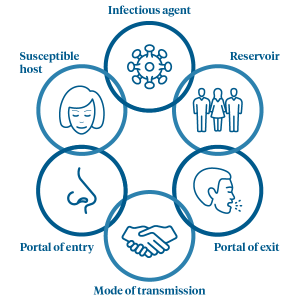Break the chain of infection with these hand hygiene best practices
Breaking just one of the links in the chain of infection can help reduce risk, keeping your patients – and you – healthier. Covering a cough, disinfecting surfaces and social distancing are simple ways to do this, but good hand hygiene is the most important step in preventing infection.
Here are four best practices to help break the chain of infection.
 What is the chain of infection?
What is the chain of infection?
The “chain of infection” is a common phrase used to describe the six main sources, or links, of infection:
-
Infectious agent: pathogens/germs
-
Reservoir: where the germs live & multiply
-
Portal of exit: how germs get out
-
Mode of transmission: how germs get around
-
Portal of entry: how germs get in
-
Susceptible host: the vulnerable recipient of germ transmission
Breaking just one of these links can help reduce the risk of infection. Covering a cough, disinfecting surfaces and social distancing are simple ways to do this, but hand hygiene is the most important step in preventing infection.
“In the absence of hand hygiene, all other measures, including using PPE, are rendered less effective. It’s the single most important measure to protect from germs.”1
Breaking the chain of infection with hand hygiene
1 | Use standard precautions
Since we don’t always know who is infected with pathogens and who is not, it’s best to take standard precautions in all healthcare settings.2 Colonization occurs when microorganisms live on or in a patient or healthcare provider, but may not appear present or cause illness.
Standard precautions are the minimum prevention practices that apply to all patient care regardless of suspected or confirmed infection, and include:
-
Hand hygiene
-
Personal protective equipment (PPE): gowns, gloves, masks, eye protection, etc.
-
Safe injection practices and safe handling of needles and sharps
-
Environmental cleaning/disinfection
-
Reprocessing of reusable medical equipment
-
Respiratory hygiene and cough etiquette
2 | Clean hands often
Healthcare providers should clean hands throughout the patient visit, not just before and after.3 Keep these touch points in mind throughout patient care:
-
Before and after contact with each patient
-
Before performing an aseptic technique (such as injection or eye drops)
-
After contact with blood and bodily fluids
-
After contact with objects in the immediate vicinity of the patient
-
After removing PPE (gloves, gown, mask)
-
When moving from contaminated body site to clean body site during patient care
3 | Use soap and hand rubs to clean hands
Use soap and water when hands are visibly soiled with blood or bodily fluids, but in all other clinical situations, alcohol-based hand rubs are the gold standard.1
The CDC recommends 60-95% alcohol concentration in hand rubs, and when it comes to soap, antimicrobial soaps or non-antimicrobial soaps are both good options.
4 | Wash hands correctly
There is a right and wrong way to wash hands. Lathering should last for at least 20 seconds.4
When washing hands with soap and water follow these steps:
-
Wet hands with lukewarm water
-
Apply an amount of product as advised on label
-
Rub hands together vigorously for at least 20 seconds
-
Be sure to cover all surfaces of the hands and fingers
-
Rinse hands with water and dry thoroughly with a disposable towel
Access the CDC’s Guideline for hand hygiene in healthcare settings and their complete Guide to infection prevention for outpatient settings to ensure your facility has appropriate infection prevention policies in place and that staff are adhering to those protocols.
Content adapted from a live webinar event hosted by McKesson Medical-Surgical and GOJO Industries.
1: Centers for Disease Control and Prevention. Guideline for hand hygiene in health-care settings: recommendations of the healthcare infection control practices advisory committee and the HICPAC/SHEA/APIC/IDSA hand hygiene task force
2: Hospital Infection Control Practices Advisory Committee (HICPAC). Recommendations for application of standard precautions for the care of all patients in all healthcare settings
3: Centers for Disease Control and Prevention. Guide to infection prevention for outpatient settings
4: https://www.cdc.gov/handwashing/when-how-handwashing.html